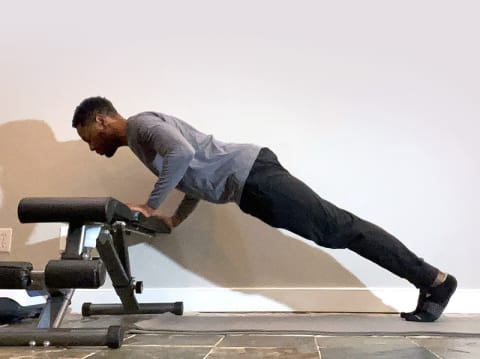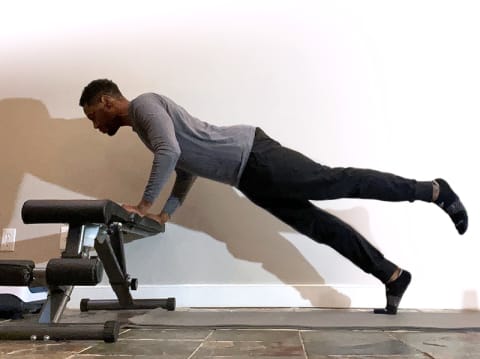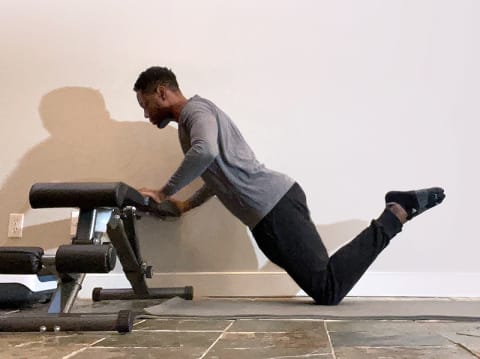Advertisement
How To Do An Incline Pushup (Plus Modifications To Suit Your Fitness Level)

Trying to incorporate pushups into your routine, but still building up your strength? Enter: the incline pushup, aka a pushup with your hands on a raised surface. They're super simple to do, great for beginners, and all you need to get started is a raised surface like a bench, box, or countertop.
Here's how to do incline pushups properly, the benefits, plus how to modify the move to suit your athletic needs, according to two personal trainers.
How to do an incline pushup:

- Choose an elevated surface (a bench, block, etc.) for your pushups, noting the higher up you are, the easier the pushups will be.
- Begin in front of your surface, placing your hands about shoulder-width apart.
- Step back one leg at a time to come into a high plank. Find stability here, with the back of the legs active and the core engaged to protect the low back. Bring your gaze slightly forward to keep the neck straight. The body is in one straight line.
- Slowly start bending your arms, elbows squeezing slightly toward the body, and lower your body until you're hovering just above your bench. Keep core and legs active.
- Straighten the arms to come back up to your high plank.
- Aim for 3 sets of 10 incline pushups.
What are the benefits?
Target muscles:
According to certified personal trainer and meditation coach Jason Williams, NASM-CPT, incline pushups primarily work the shoulders, triceps, and chest, including the pectoralis major and minor.
"The wider your arms, the more they target your chest," adds certified personal trainer Krista Stryker, NSCA-CPT. "If your arms are more narrow, they'll target your triceps and shoulders more."
You'll definitely feel it more in your chest compared to a normal pushup. In addition to working the upper body, with proper form, you'll also be working your core, back, and leg muscles, too.
What makes it different?
"Incline pushups are easier than regular or decline pushups," Williams says, adding this makes them "great for someone who struggles with normal flat pushups." Regular pushups are great for working the upper body and core, but if you're focusing on building strength, the incline significantly reduces the amount of weight you're pushing.
"I particularly love incline pushups as a way to build up to doing a full pushup on the floor," Stryker says, "and prefer them to knee pushups at helping to build up strength and proper pushup form."
Common mistakes and risks to watch out for.
In any pushup, it's not uncommon to see necks out of alignment, as well as sagging or piking in the hips and lower back. This can be avoided with proper form, though. Try looking slightly in front of your hands, Stryker suggests, rather than looking directly at your hands, to avoid a kink in your neck. And to keep hips in line, "Make sure to engage your core," she notes.
If you have a shoulder injury, it's probably best to avoid pushups—check with your doctor before giving them a try. Similarly, elbow and wrist injuries may not fare well here, either. However, incline pushups do put less pressure on those joints than regular pushups.
How to modify incline pushups.
To make it harder:

Remembering that the lower the bench, the more difficult the pushup will be, you can simply reduce the height of your surface (or, of course, trying out a regular pushup).
Williams says you can also perform incline pushups with a single leg lifted, to work one leg at a time. And to challenge your balance and core strength a bit more, try placing your hands on an exercise ball rather than something solid.
To make it easier:

One way to make incline pushups easier is to come to your knees. In addition to that, "The higher the surface, the easier incline pushups will be," Stryker says. "So doing them on a countertop will be easier than on a low bench." Keep increasing the height until you find one that works for you. You can even try wall pushups in the very beginning and get used to the movement of pushing away from the wall at a very slight incline.
The bottom line.
Pushups are a go-to exercise for a reason, but if they're not quite accessible to you yet, incline pushups are a great place to start. With the ability to adjust your incline to any height that works for you, you can work on your strength and form, and soon enough, you'll be making serious pushup progress.